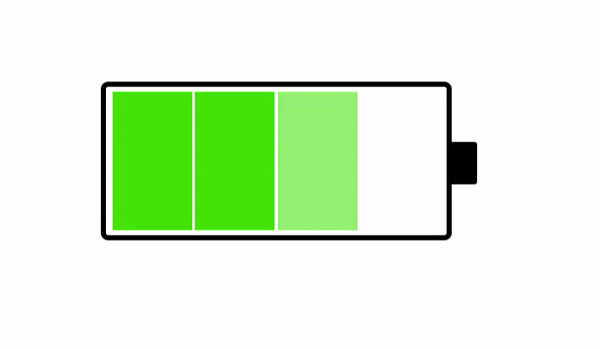1. Understanding Lodging Business
① Definition of Lodging Business
The term ‘lodging business’ is used with various implications in Korea. It sometimes means lodging business implicating an activity of supplying lodging products to the market, sometimes means lodging enterprise implicating the subject of such activities, and sometimes means lodging industry implicating the entire set of them. This ambiguity often causes misinterpretation of relevant regulations and statistics, which may eventually grow to larger problems that cannot be resolved straightforwardly.
② Elements of Lodging Business
Lodging business means an activity of providing a place together with services on a daily basis for people to stay temporarily away from home. In other words, its starting points are a lodging property in a broad sense and a lodging enterprise producing and providing services out of it. A lodging property in a broad sense means any property used for a lodging business, while a lodging business in a narrow sense is a property permitted only for lodging business pursuant to the Building Act. For example, a single-family house used as a rural minbak is not a lodging property in a narrow sense but a lodging property in a broad sense.
③ Split between Ownership and Operations
Traditionally, a lodging enterprise was the owner of the lodging property, and there was not much need to view them separately. However, lodging enterprises started to diverge from ownership of lodging properties, along with changing competitive environment in the lodging industry. The key driver was the need for isolating two different cycles in capital management, working against each other: the owner of a lodging property wanted to maximize capital gain on a long-term basis, while the lodging enterprise needed to maximize operating profit on a short-term basis.
2. Interpreting the Report
① Definition of Lodging Establishment
A lodging establishment means a minimum set of assets to produce and distribute lodging products independently, based on a combination of a lodging property and a lodging enterprise. The concept is built upon the many-to-many relationship between lodging properties and lodging enterprises, which became prevalent along with split of ownership and operations. For example, the number of lodging establishments is equal to the number of lodging enterprises, if multiple lodging enterprises run lodging businesses independently in a lodging property. On the other hand, the number of lodging establishments is equal to the number of lodging properties, if a lodging enterprise operates multiple lodging properties separately at different locations.
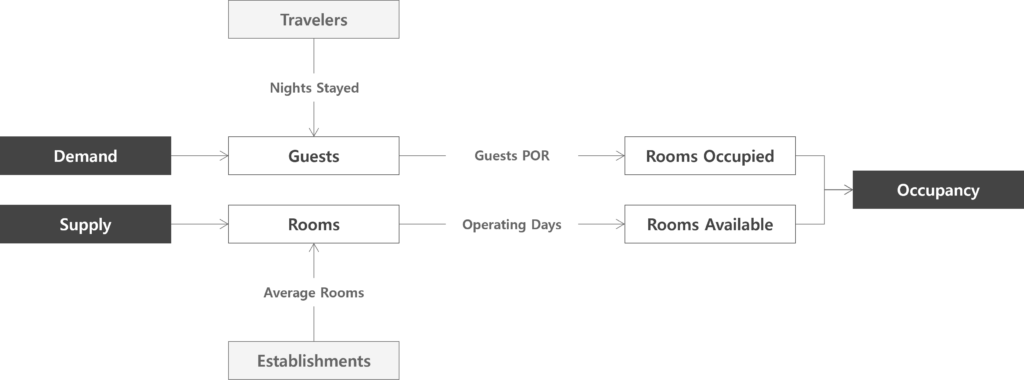
② Classification of Supply
This report uses the Establishment Types as the classification system of supply, which incorporates the classification systems of lodging establishment types pursuant to individual regulations, building types of lodging properties pursuant to the Building Act, and business types of lodging enterprises pursuant to the Business Type Code. As such, the data for lodging establishments are classified and compiled into tourist hotels, other hotels, resort condos, general lodgings, residential lodgings, rural minbaks, urban minbaks and other lodgings.
③ Measurement of Supply
The number of establishments, the number of rooms and the number of rooms available are the major indicators of supply volume. The number of rooms available means the total number of room products available for daily sales in a year, calculated as the number of rooms multiplied by the number of operating days in a year. Also, the average number of rooms is the indicator of scale of establishments, calculated as the number of rooms divided by the number of establishments. This report measures trends and status of supply based on the compounded annual growth rate and the fair share of supply indicators for a specified period of time.
④ Classification of Demand
The lodging demand means guests who stay temporarily at lodging establishments away from home. The lodging demand can be broken down by various criteria, but this report breaks it down into domestic and international demands by origin, and into leisure and other demands by purpose. Moreover, they can be further broken down based on consumption patterns: by age group in the case of domestic demand, and by nationality in the case of international demand.
⑤ Measurement of Demand
The number of guests is the major indicator of demand volume, and the number of rooms occupied is the major indicator of consumption volume. However, it should be noted that they capture only accommodated demand but not all of potential demand. Also, the occupancy is the indicator of balance between supply and demand, calculated as the number of rooms occupied divided by the number of rooms available, and the number of guests per occupied room is the indicator of productivity by demand group, calculated as the number of guests divided by the number of rooms occupied. This report measures trends, status and stability of demand based on the market share and the volatility of demand indicators for a specified period of time. In this report, the volatility is calculated as the standard deviation divided by the average.
3. Sorting through the Supply
- Establishments: Increased by 3.8% per year from 33K in 2005 to 62K in 2022, 48% from Rural Minbak in 2022
- Rooms: Increased by 1.6% per year from 758K in 2005 to 991K in 2022, 44% from General Lodging in 2022
① Diversification of Establishment Types
The number of lodging establishments in Korea increased by 3.8% per annum, from 33 thousand in 2005 to 62 thousand in 2022. Especially, the increase has been notable for relatively new types such as rural minbak, urban minbak and residential lodging, while general lodging, which has accounted for the largest share, has continuously decreased.
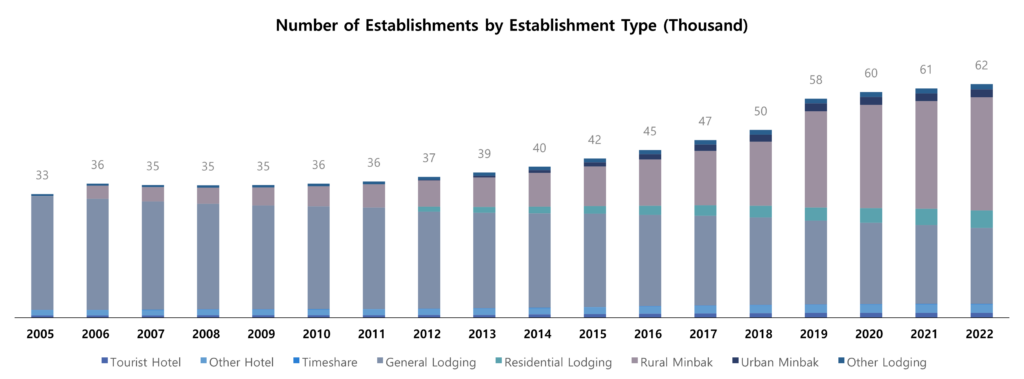
The supply of rural minbaks began to be captured in public statistics at the end of 2005, when its business registration system changed from reporting basis to approval basis. The supply of urban minbaks began to be captured in public statistics upon legislation at the end of 2011, and the supply of residential lodgings did upon separation from the general lodging at the beginning of 2012.
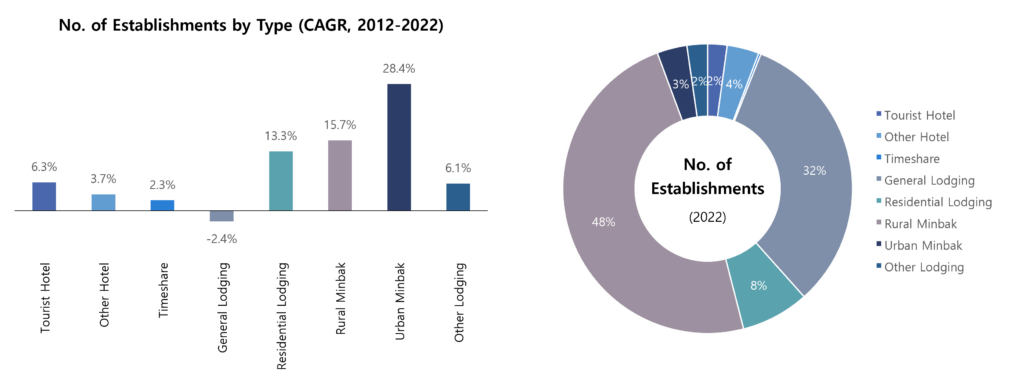
The number of hotels has increased continuously despite its high entry barrier, as some of non-hotel establishments were incorporated into the hotel upon addition of new sub-types under the hotel. The hostel was created in 2009, and the small hotel and the medical hotel were created in 2014 as sub-types of the hotel.
As of 2022, the rural minbak accounted for the largest share of 48% in the number of establishments, followed by the general lodging with 32% share and the residential lodging with 8% share.
The number of rooms increased by 1.6% per annum, from 758 thousand in 2005 to 991 thousand in 2022. Despite the continuous increase, the magnitude was significantly lower than that of establishments, 3.7% per annum. It is because the most increase in the number of rooms occurred in segments of smaller establishments.
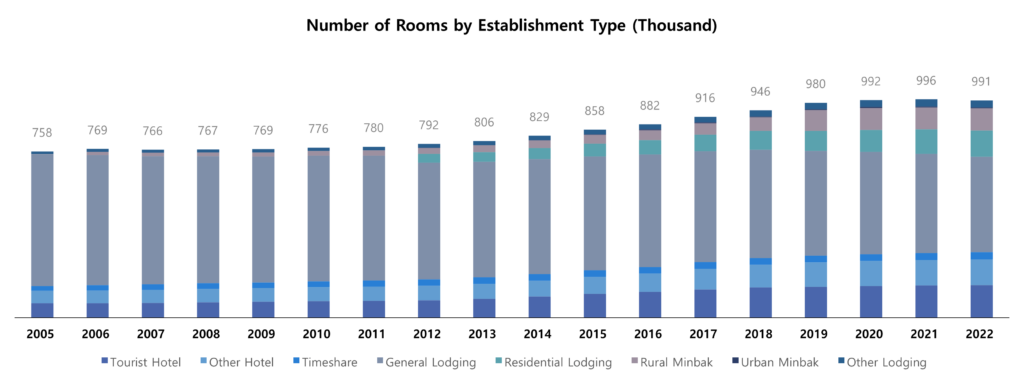
The rural minbak and the urban minbak should use a single-family house or a multi-family housing unit, instead of a lodging property, and the lodging business must be a side line. Also, the floor area used for dwelling and lodging business combined is not allowed to exceed 230㎡ by regulation.
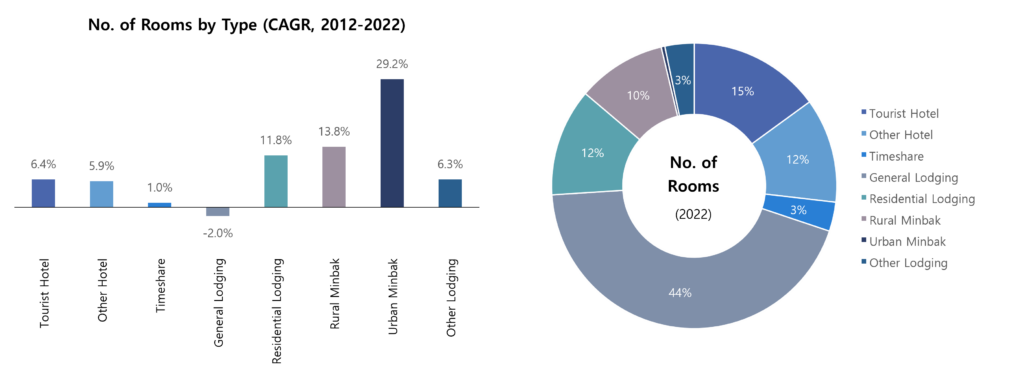
The reason that the growth rate of the number of rooms for urban minbaks exceeds that of the number of establishments despite the same size limit with rural minbaks, in the CAGR graph above, is because the growth rates are calculated from 2012. There exists a difference in sample size, as 2012 was right upon legislation of the urban minbak while it was 6 years after de facto legislation of the rural minbak.
As of 2022, the general lodging accounted for the largest share of 44% in the number of rooms, followed by the tourist hotel with 15% share and the other hotel and the residential lodging with 12% share each.
② Downsizing of Establishments
Downsizing spread across the entire lodging industry along with the rapid increase of small lodging establishments with the statutory size limit. The average number of rooms of lodging establishments decreased by 2.1% per annum from 23 in 2005 to 16 in 2022.
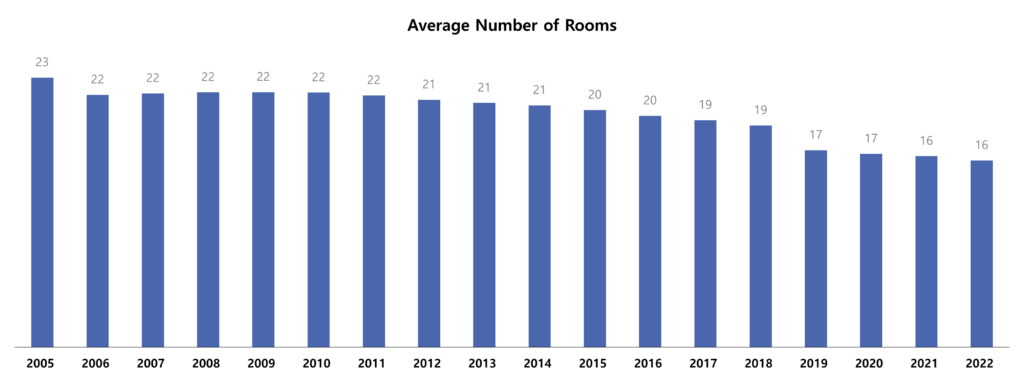
The average number of rooms of rural minbaks, which has played the key role in downsizing across the lodging industry, expedited downsizing even further through the decrease by 1.7% per annum from 2012 to 2022. The average number of rooms of residential lodgings decreased as well by 1.3% per annum, while its number of rooms increased by 11.8%.
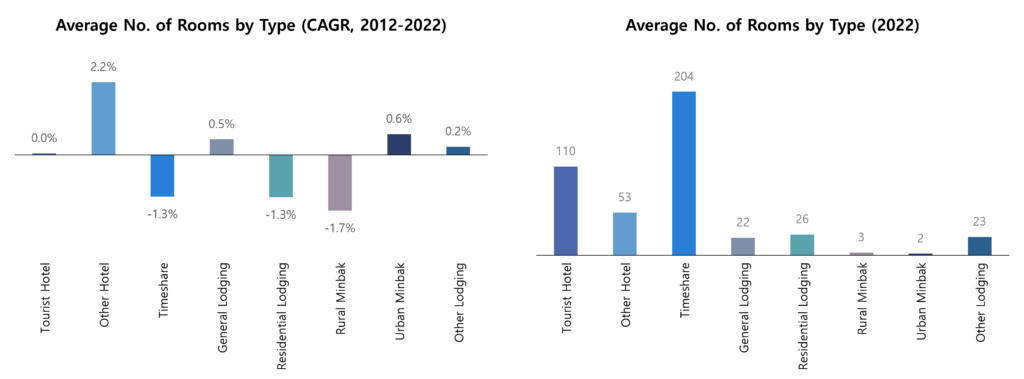
As of 2022, the largest type of establishment was the resort condo with the average number of rooms of 204, followed by the tourist hotel with 110 rooms and the other hotel with 53 rooms.
Although the average number of rooms of the resort condo has decreased by 1.3% per annum since 2012, it is still the largest type of establishment as compared to the others. On the other hand, the average number of rooms of the other hotel was 53, bringing it into the large unit-size group, was the outcome of continuous increase in the average number of rooms by 2.2% per annuam since 2012.
The smallest type of establishment was the urban minbak with the average number of rooms of 2, followed by the rural minbak with 3 rooms.
4. Sorting through the Demand
- Domestic: 75% of guests by Domestic/Leisure (2005-2022), 50% of Domestic at General Lodging (2012-2022)
- International: 10% of guests by International/Leisure (2005-2022), 60% of International at Hotel (2012-2022)
① Domestic Leisure Market
Domestic leisure demand has supplied the largest volume to the lodging market of Korea, on a stable basis. It accounted for 75% of total number of guests from 2005 to 2022, with the lowest volatility of 20.5% among 4 demand segments.
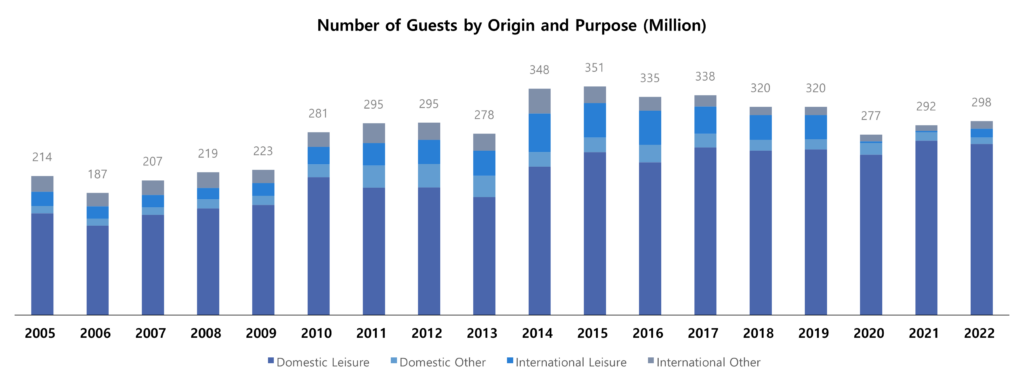
On the other hand, international leisure demand accounted for 10% of total number of guests for the same period of time, with the highest volatility of 55.7%.
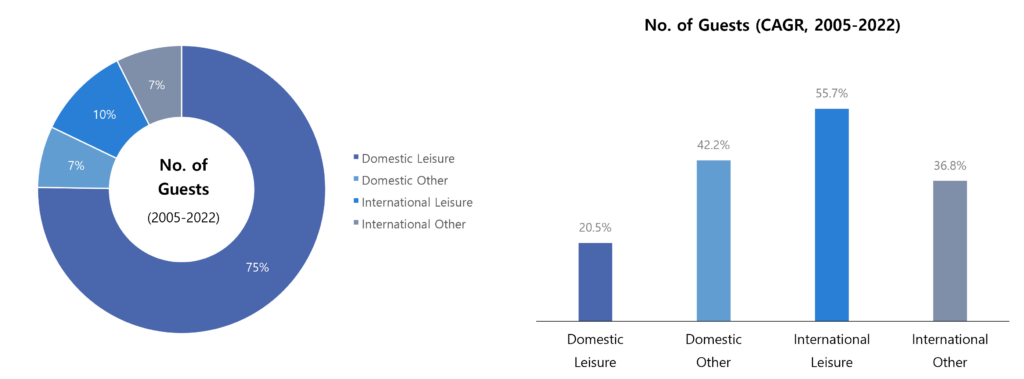
Most regions in Korea fall under the one-day living zone, due to the small territory with a sophisticated transportation system. As such, there are not many domestic business travelers, and leisure travelers account for majority of domestic demand, with concentration in vacation seasons. In other words, domestic demand demonstrates a high degree of seasonality, which often results in a low level of annual occupancy.
Nevertheless, the comsumption price is generally higher for international demand than for domestic demand across most countries, and the operating profit of lodging establishments is likely to be higher with more international demand. However, the heavy reliance on international demand is accompanied by increased need for working capital to secure stability of cash flows, due to the volatility brought up by international demand.
② General Lodgings for Domestic Demand
Generally, domestic demand is impacted much by internal factors, such as income, inflation and interest rate, but not as much by external factors, such as exchange rates, pandemic and international politics. In fact, there was not much of meaningful chage in domestic demand when the global financial crisis spread throughout the world in 2009, when MERS flew into Korea in 2015, and when COVID-19 brought the entire world to standstill in 2020.
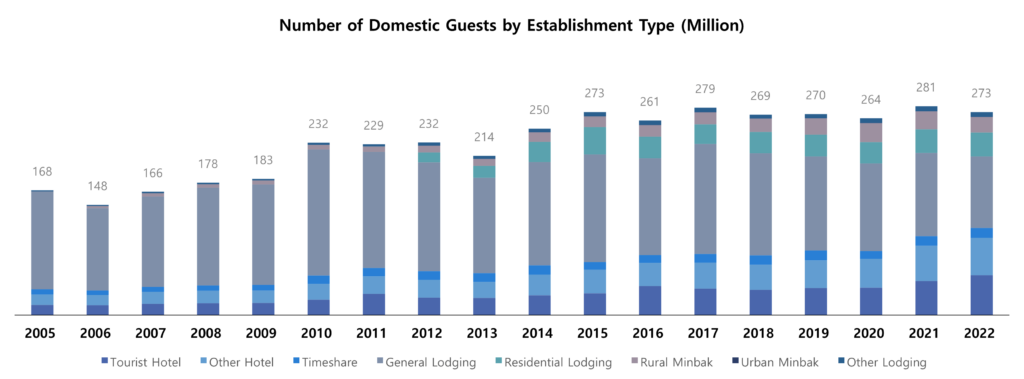
The consumption pattern of domestic demand typically traced the supply mix. From 2012 to 2022, the general lodging, which supplied the most rooms, took the most domestic guests with 50% share, while the urban minbak, which supplied the least rooms, took the least domestic guests.
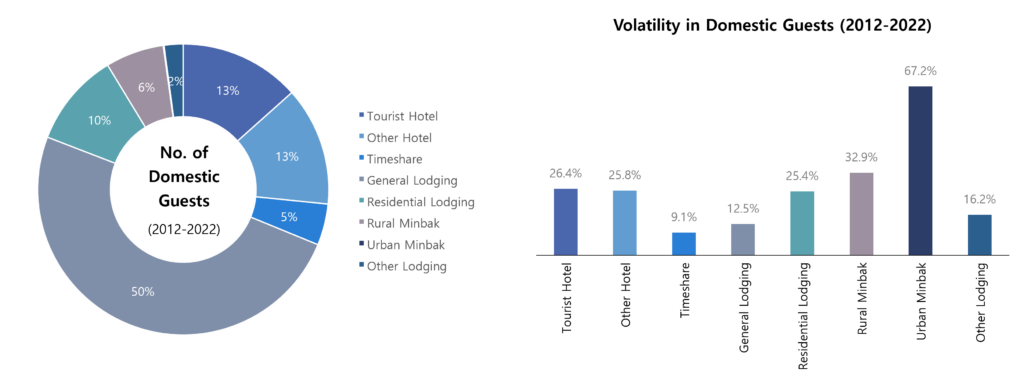
During the period, domestic demand was the most stable at resort condos with the volatility of 9.1%, while it was the least stable at urban minbaks with the volatility of 67.2%. For the other types, the more the number of rooms was, the more stable the domestic demand stream was.
③ Hotels for International Demand
On the other hand, international demand is impacted significantly by external factors, such as exchange rate, pandemic and international politics. Also, the impact of income, inflation and interest rate by country applies more complicatedly, as the international demand is composed of guests from various countries. Therefore, its volatility is much higher than that of domestic demand. For example, Japanese guests increased rapidly from 2009 to 2012 due to the appreciation of JPY, but decreased rapidly from 2013 due to the depreciation of JPY. On the other hand, Chinese guests increased explosively from 2013 to 2014 due to the spread of Korean Wave, but disappeared following MERS in 2015 and the ban on Korean culture triggered by THAAD deployment in 2016.
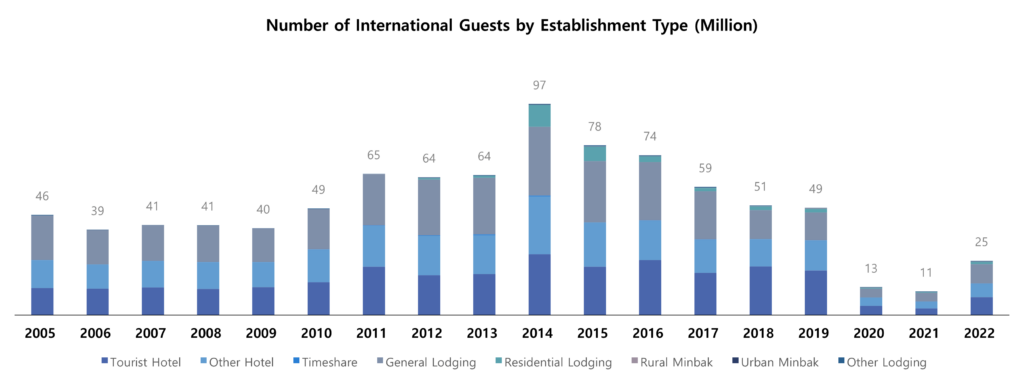
International demand tended to prefer hotels, the unit size of which is relatively large. Tourist hotels and other hotels absorbed 60% of international guests from 2012 to 2022, while the absorption by rural minbaks, urban minbaks and other lodgings was negligible.
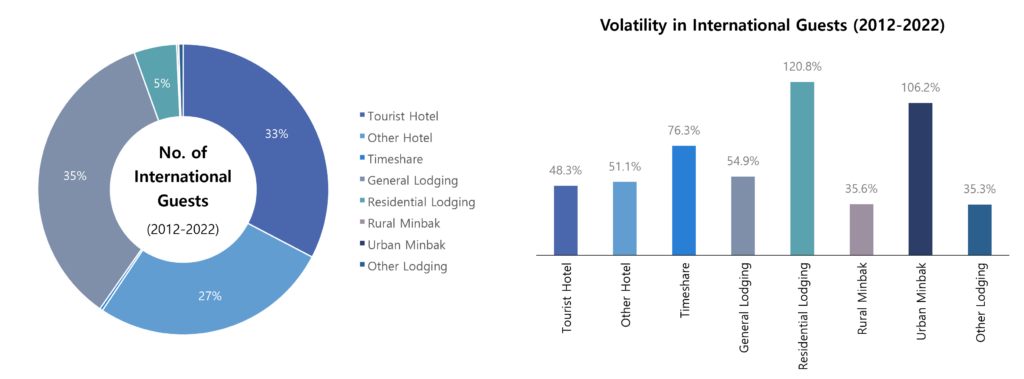
During the period, excluding rural minbaks, urban minbaks and other lodgings with negligible shares in absorbing international guests, the international demand was the most stable at tourist hotels with the volatility of 48.3%, while it was the least stable at residential lodgings with the volatility of 120.8%. In short, the larger the international demand share was, the more stable the international demand stream was.
5. Balancing Supply and Demand
- Rooms Occupied: General Lodging 50% of rooms, 54% of guests and 51% of rooms occupied for 2012-2022
- Occupancy: Residential Lodging 57.0%, General Lodging 26.9% and Other Lodging 26.8% for 2012-2022
One of the key characteristics of lodging market is that the demand is elastic while the supply is inelastic. In the short term, a lodging establishment supplies the same number of products everyday, while the demand changes everyday. In the long term, it takes about 2 to 3 years from planning to launching a new lodging establishment, while the demand can change dramatically during the period, due to the complicated impact of various internal and external factors.
The asymmetry of supply and demand can be observed in the difference in shares between the number of rooms and the number of guests by lodging establishment. The general lodging supplied 54% of rooms from 2012 to 2022, and absorbed 47% of guests. During the period, the hotel supplied 23% of rooms, and absorbed 32% of guests. In other words, the supply share was higher than the demand share for general lodgings, while the demand share was higher than the supply share for hotels.
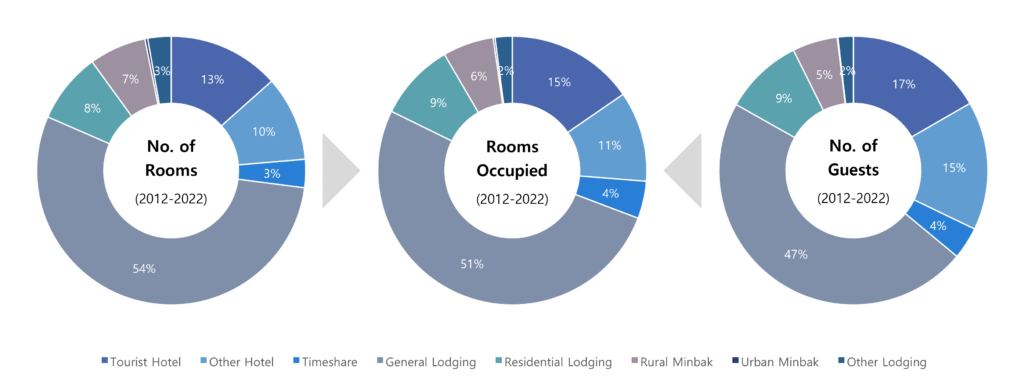
The lodging market always figures out a compromising point of asymmetric supply and demand. The number of rooms occupied is the indicator of the compromising point in volume, and used as the basis for measuring the market share. The general lodging, which supplied 54% of rooms and absorbed 47% of guests from 2012 to 2022, accounted for 51% of rooms occupied. The hotel, which supplied 23% of rooms and absorbed 32% of guests, accounted for 26% of rooms occupied for the period. The general lodging is retaining the largest market share in the lodging market of Korea.
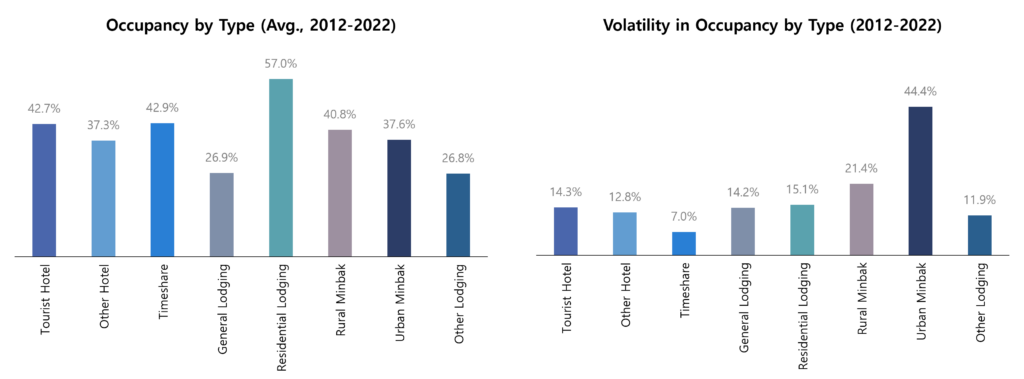
The occupancy is the indicator of the compromising point presented as a ratio to supply volume, and used as the basis for measuring balance between supply and demand. A high occupancy indicates an undersupply status, and a low occupancy indicates an oversupply status. The occupancy from 2012 to 2022 was the highest at residential lodgings with 57.0%, and the lowest at general lodgings and other lodgings with 26.9% and 26.8%, respectively. In other words, the general lodging, which retains the highest market share, showed a clear sign of oversupply. During the period, the occupancy was the most stable at resort condos with the volatility of 7.0%, and it was the least stable at urban minbaks with the volatility of 44.0%.
However the interpretation of the number of rooms occupied and the occupancy should be conducted cautiously. The compromise between asymmetric supply and demand can be affected by productivity of guests as well as their volumes. For example, the consumption patterns may differ by demand group, such as the number of guests staying in the same number of rooms. If more guests stay in the same number of rooms, the productivity of guests can be assessed less productive, while it can be assessed more productive with fewer guests.
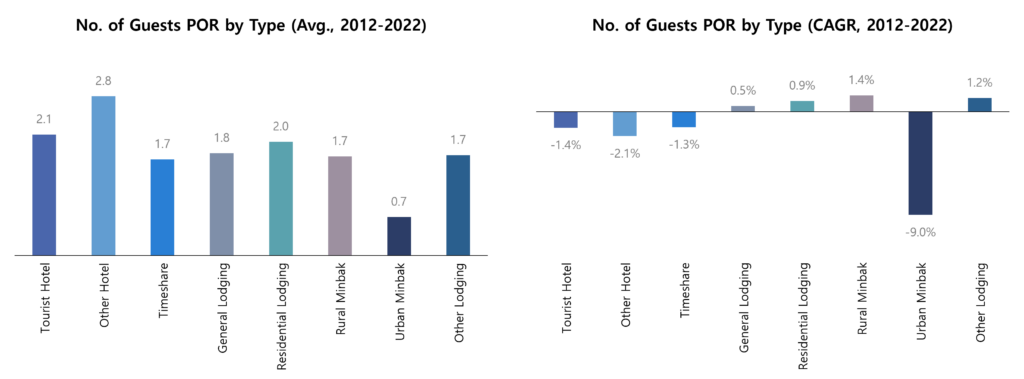
The number of guests per occupied room is the indicator to measure the productivity of guests. From 2012 to 2022, the urban minbak demonstrated the highest productivity of guests with the number of guests per occupied room of 0.7, while the other hotel demonstrated the lowest productivity of guests with the humber of guests per occupied room of 2.8. During the period, the productivity of guests increased further at urban minbaks with the decrease in the number of guests per occupied room by 9.0% per annum. Tourist hotels, other hotels and resort condos also demonstrated increased productivity. On the other hand, the productivity of guests decreased at general lodgings, residential lodgings, rural minbaks and other lodgings.
Apparently, the number of guests per occupied room may be a reaction by guests to the market condition rather than a matter of their productivity. For example, more guests may stay in fewer rooms if availability of rooms is limited at a preferred type of lodging establishment for a preferred time and location, or if the price rose too much at the preferred lodging establishment and became burdensome.
6. Expanding on the Report
<a href="https://lobin.co/en/" target="_blank" rel="noopener noreferrer">Lobin Co.</a>, "<a href="https://lobin.co/en/insight/lodging-market-korea-2023/" target="_blank" rel="noopener noreferrer">Lodging Market Korea 2005-2023</a>"
